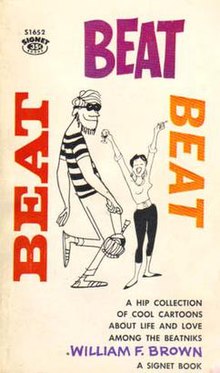
Back ثقافة البيت Arabic Beatnik AST Beatnik Catalan Beatnik Danish Beatnik German Beatnik Spanish Biitnik Estonian جنبش بیت Persian Beatnik Finnish Beatnik French

Beatniks were members of a social movement in the mid-20th century, who subscribed to an anti-materialistic lifestyle. They rejected the conformity and consumerism of mainstream American culture and expressed themselves through various forms of art, such as literature, poetry, music, and painting. They also experimented with spirituality, drugs, sexuality, and travel. The term "beatnik" was coined by San Francisco Chronicle columnist Herb Caen in 1958, as a derogatory label for the followers of the Beat Generation, a group of influential writers and artists who emerged during the era of the Silent Generation's maturing, from as early as 1946 to as late as 1963, but the subculture was at its most prevalent in the 1950s. The name was inspired by the Russian suffix "-nik", which was used to denote members of various political or social groups. The term "beat" originally was used by Jack Kerouac in 1948 to describe his social circle of friends and fellow writers, such as Allen Ginsberg, William S. Burroughs, and Neal Cassady. Kerouac said that "beat" had multiple meanings, such as "beaten down", "beatific", "beat up", and "beat out". He also associated it with the musical term "beat", which referred to the rhythmic patterns of jazz, a genre that influenced many beatniks.
Beatniks often were stereotyped as wearing black clothing, berets, sunglasses, and goatees, and speaking in hip slang that incorporated words like "cool", "dig", "groovy", and "square". They frequented coffeehouses, bookstores, bars, and clubs, where they listened to jazz, read poetry, discussed philosophy, and engaged in political activism. Some of the most famous beatnik venues were the Six Gallery in San Francisco, where Ginsberg first read his poem "Howl" in 1955; the Gaslight Cafe in New York City, where many poets performed; and the City Lights Bookstore, also in San Francisco, where Kerouac's novel On the Road was published in 1957. Beatniks also traveled across the country and abroad, seeking new experiences and inspiration. Some of their destinations included Mexico, Morocco, India, Japan, and France.
Beatniks had a significant impact on American culture and society as they challenged the norms and values of their time. They influenced many aspects of art, literature, music, film, fashion, and language. They also inspired many social movements and subcultures that followed them, such as the hippies, the counterculture, the New Left, the civil rights movement, the feminist movement, the environmental movement, and the LGBT movement. Some of the more notable figures who were influenced by or associated with beatniks include Bob Dylan, The Beatles, Andy Warhol, Ken Kesey, and Timothy Leary. Beatniks have been portrayed or parodied in many works of fiction, such as The Many Loves of Dobie Gillis, A Charlie Brown Christmas, The Munsters, The Flintstones, The Simpsons, and SpongeBob SquarePants.